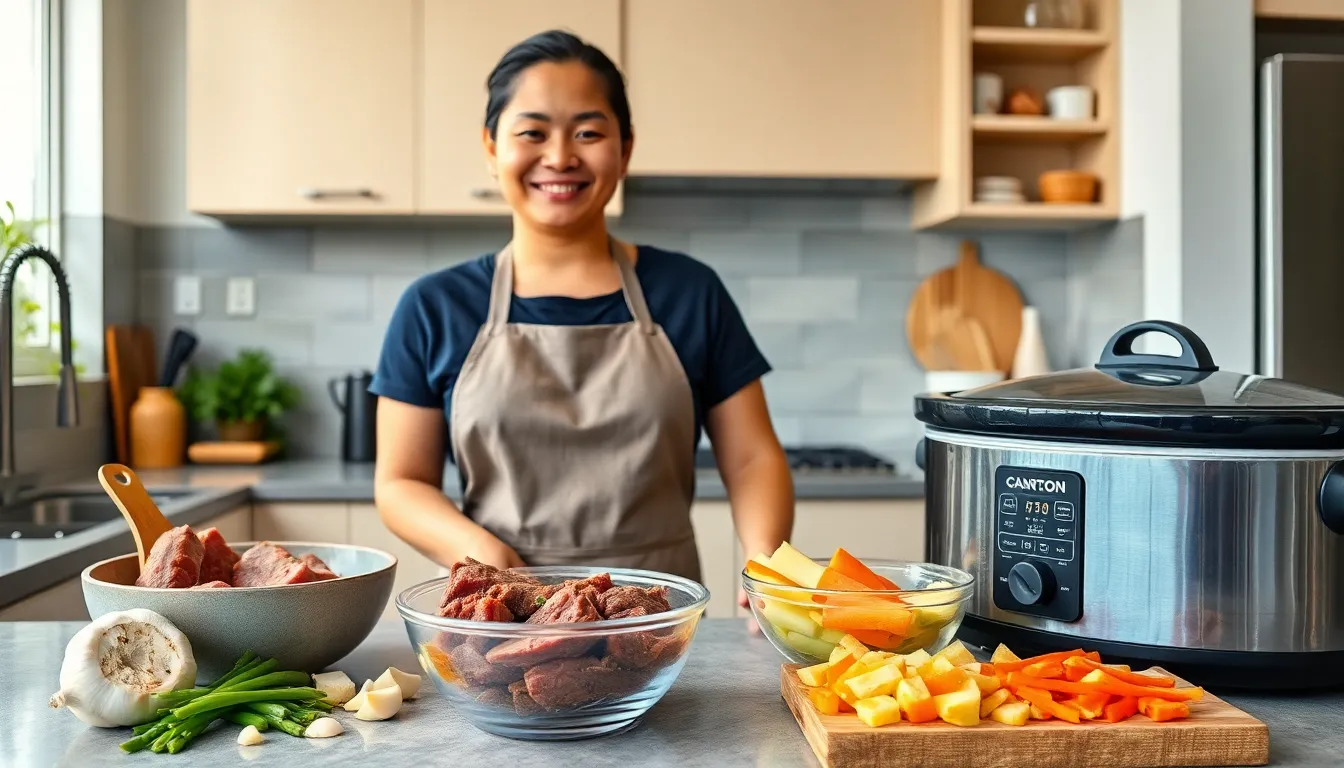Filipino beef stew brings together the perfect harmony of tender beef and rich tomato-based flavors that’ll transport your kitchen straight to the Philippines. This beloved comfort food combines Spanish colonial influences with local Filipino ingredients creating a dish that’s both familiar and exotic.
We’ve perfected this recipe to deliver melt-in-your-mouth beef chunks swimming in a savory sauce that’s been slow-cooked to perfection. The secret lies in the perfect balance of soy sauce, tomato sauce, and aromatic spices that create layers of complex flavors your family will absolutely love.
What makes our Filipino beef stew special is how it transforms simple ingredients into something extraordinary. The potatoes absorb all those incredible flavors while the carrots add natural sweetness that complements the rich beef perfectly. This one-pot wonder will become your go-to recipe for busy weeknights when you want something hearty and satisfying.
Ingredients
We carefully select each ingredient to build layers of authentic Filipino flavor in our beef stew. Our ingredient list balances traditional elements with accessible pantry staples to create this soul-warming dish.
For the Beef
- 2 pounds beef chuck roast, cut into 2-inch cubes
- 2 tablespoons vegetable oil
- 1 teaspoon salt
- 1/2 teaspoon black pepper
- 2 tablespoons all-purpose flour
For the Vegetables
- 3 medium potatoes, peeled and quartered
- 2 large carrots, sliced into 1-inch pieces
- 1 large onion, diced
- 4 cloves garlic, minced
- 1 red bell pepper, cut into strips
- 1 cup green peas (fresh or frozen)
For the Sauce
- 1/4 cup soy sauce
- 1 can (8 ounces) tomato sauce
- 2 tablespoons tomato paste
- 2 cups beef broth
- 2 bay leaves
- 1 teaspoon sugar
- 1/2 teaspoon paprika
- 1/4 teaspoon ground black pepper
Equipment Needed

Creating our authentic Filipino beef stew requires just a few essential pieces of cookware that will help us achieve the perfect texture and flavor balance. We recommend gathering these tools before starting our cooking process to ensure smooth preparation from start to finish.
Heavy Pot or Braiser (3-4 Quarts)
Our most important piece of equipment is a sturdy heavy-bottomed pot or braiser with a tight-fitting lid. This vessel will handle the slow simmering process that transforms tough beef chunks into tender, melt-in-your-mouth pieces. The heavy bottom prevents scorching during the extended cooking time while maintaining even heat distribution throughout our stew.
Medium Skillet
We need a reliable medium skillet for browning our beef and sautéing aromatics like garlic and onions. This initial browning step creates the foundation of flavor that makes our Filipino beef stew exceptional. The skillet should be large enough to brown beef in batches without overcrowding.
Mixing Bowl
Our marinating process requires a medium to large mixing bowl where we can properly coat our beef chunks with soy sauce, lemon juice, and seasonings. This bowl should be non-reactive material like glass or stainless steel to prevent any metallic flavors from affecting our marinade.
| Equipment | Size/Capacity | Primary Use |
|---|---|---|
| Heavy Pot/Braiser | 3-4 quarts | Slow simmering stew |
| Medium Skillet | Standard size | Browning beef and sautéing |
| Mixing Bowl | Medium-large | Marinating beef |
These three essential pieces form the backbone of our cooking setup. The heavy pot ensures our beef becomes perfectly tender through slow cooking, while the skillet develops those crucial caramelized flavors. Our mixing bowl allows proper marination that infuses every piece of beef with authentic Filipino seasonings before cooking begins.
Instructions

Follow these step-by-step instructions to create an authentic Filipino beef stew that delivers rich flavors and tender meat. Each stage builds upon the previous one to develop the complex taste profile that makes this dish special.
Prep the Beef
Cut 2 pounds of beef chuck roast into 2-inch cubes for optimal cooking consistency. Place the beef cubes in your mixing bowl and add 1/4 cup dark soy sauce along with the juice of half a lemon. Season generously with freshly ground black pepper and toss until all pieces are evenly coated. Allow the beef to marinate for at least 30 minutes at room temperature. This marination process tenderizes the meat while infusing it with savory and tangy flavors that form the foundation of our stew.
Prepare the Vegetables
Peel and cut 3 large potatoes into 2-inch chunks that will hold their shape during the long cooking process. Slice 3 medium carrots into thick diagonal pieces about 2 inches long. Remove the seeds from 1 red bell pepper and slice it into strips. Dice 1 medium onion into small pieces and mince 3 garlic cloves finely. Having all vegetables prepped and ready ensures smooth cooking once we begin the searing and simmering process.
Make the Base
Heat 3 tablespoons of cooking oil in your heavy pot over medium-high heat until it shimmers. Add the minced garlic first and sauté for 30 seconds until fragrant. Stir in the diced onions and cook for 3-4 minutes until they become translucent and softened. Remove the beef from the marinade and reserve the liquid for later use. Brown the beef cubes in batches to avoid overcrowding the pot. Each batch should sear for 2-3 minutes per side until a golden crust forms. Add 1 teaspoon of fish sauce to the pot and stir to combine. Pour in 1 cup of tomato sauce and 1.5 cups of beef stock while scraping up any browned bits from the bottom. Drop in 2 bay leaves for aromatic depth.
Combine and Simmer
Return all the browned beef to the pot along with the reserved marinade liquid. Bring the mixture to a rolling boil over high heat. Reduce the heat to low and cover the pot with a tight-fitting lid. Let the stew simmer gently for 1.5 hours while stirring occasionally to prevent sticking. The beef should become fork-tender and the sauce should reduce to a rich consistency. Check the liquid level periodically and add more beef stock if needed to prevent burning.
Final Assembly
Add the prepared potatoes and carrots to the simmering stew during the last 30 minutes of cooking time. The vegetables need enough time to become tender without falling apart. Stir in the sliced bell pepper during the final 10 minutes of cooking to maintain its vibrant color and slight crunch. Taste the stew and adjust seasoning with salt and freshly ground pepper as needed. Remove the bay leaves before serving. Ladle the finished stew over steamed white rice for the complete Filipino dining experience.
Cooking Tips for Perfect Filipino Beef Stew

Marinate for maximum tenderness. We recommend letting your beef soak in the soy sauce and lemon juice mixture for at least 30 minutes. This process breaks down tough muscle fibers while infusing deep Filipino flavors throughout each piece of meat.
Brown the beef thoroughly for complex flavors. When we sear the marinated beef in batches, we create a rich foundation that elevates the entire stew. Each piece should develop a golden-brown crust that locks in juices and adds depth to our final dish.
Choose quality soy sauce for authentic taste. Dark soy sauce like Silver Swan brings the traditional Filipino flavor profile we’re seeking. This exact type adds both color and umami richness that regular soy sauce simply cannot match.
Embrace the slow simmer method. Low and steady heat transforms tough beef chuck into fork-tender perfection over 1.5 hours. We never rush this process because proper slow cooking allows collagen to break down into silky gelatin that thickens our sauce naturally.
Time your vegetables perfectly. Adding potatoes and carrots during the final 20 minutes prevents them from turning mushy while ensuring they absorb the stew’s flavors. We want vegetables that hold their shape while being tender enough to cut with a fork.
Reserve some marinade for extra flavor. We always save 2 tablespoons of the beef marinade to add back into the pot during cooking. This technique intensifies the overall taste and maintains consistency in our flavor profile.
Adjust seasonings at the end. Final seasoning adjustments happen after all ingredients have melded together. We taste and balance the salty, tangy, and sweet elements using salt, pepper, fish sauce, or even a dash of Tabasco for heat.
Serve with steamed rice for tradition. Filipino beef stew pairs best with fluffy white rice that soaks up every drop of the rich tomato-based sauce. This combination creates the authentic dining experience that makes this dish a Filipino household favorite.
Serving Suggestions

We recommend serving our Filipino beef stew hot over freshly steamed white rice as the traditional accompaniment. This classic pairing allows the fluffy rice to absorb the rich tomato-soy sauce while balancing the robust flavors of the tender beef chunks.
Garnishing options enhance both presentation and flavor profiles. Fresh chopped parsley adds a bright pop of color and herbaceous notes that complement the savory stew. Green onions provide a mild onion flavor with visual appeal when sprinkled over the finished dish.
Side dishes create a well-rounded Filipino meal experience. Sautéed vegetables like kangkong or green beans offer fresh contrast to the hearty stew. A simple cucumber salad with vinegar dressing provides cooling crispness that cuts through the rich sauce.
Leftover storage actually improves our stew’s flavor development. The next day brings deeper taste as all ingredients meld together during refrigeration. We reheat portions gently on the stovetop with a splash of water if needed to restore the sauce consistency.
Portion control makes this recipe versatile for different occasions. Family dinners benefit from generous servings over rice with multiple side dishes. Individual lunch portions work well in meal prep containers with pre-portioned rice for convenient reheating.
Bread alternatives offer variation from traditional rice service. Crusty Filipino pandesal or warm dinner rolls make excellent vehicles for soaking up the flavorful sauce. These options particularly appeal to those seeking different textures alongside the tender beef and vegetables.
Storage and Reheating Instructions

Proper storage extends the life of our Filipino beef stew while maintaining its rich flavors and tender texture. We recommend allowing the stew to cool completely to room temperature before transferring it to storage containers. This prevents condensation from forming inside the container which could affect the stew’s quality.
Refrigerator Storage
We transfer our cooled stew to airtight containers for optimal freshness. The stew maintains its best quality when refrigerated for up to 3-4 days. Label containers with the preparation date to track freshness and ensure food safety.
| Storage Method | Duration | Container Type |
|---|---|---|
| Refrigerator | 3-4 days | Airtight container |
| Freezer | 2-3 months | Freezer-safe container |
Freezer Storage
For longer storage periods we place the stew in freezer-safe containers leaving about an inch of headspace for expansion. Our Filipino beef stew freezes well for up to 2-3 months without important loss of flavor or texture. We always label frozen containers with both the contents and date for easy identification.
Reheating from Refrigerated
When reheating refrigerated stew we use a saucepan over medium heat stirring occasionally until the stew reaches steaming temperature throughout. This gentle reheating method preserves the tender beef texture and prevents the vegetables from breaking down. We add a splash of water or beef broth if the stew has thickened during storage.
Reheating from Frozen
Frozen stew requires overnight thawing in the refrigerator before reheating. We then follow the same stovetop method using medium heat and stirring regularly. Microwave reheating works as an alternative though we prefer stovetop methods for better texture control.
Food Safety Guidelines
We avoid reheating the stew multiple times as this compromises both flavor quality and food safety. Each reheating cycle should bring the stew to a minimum internal temperature of 165°F throughout. Store any remaining portions immediately after cooling to maintain optimal freshness for future meals.
Recipe Variations

Filipino beef stew offers incredible versatility through its distinct regional variations. Each version brings unique flavors and techniques that showcase the dish’s rich culinary heritage.
Traditional Kaldereta Style
We celebrate the authentic kaldereta approach that honors Filipino cooking traditions. This version originally featured goat meat but evolved to use beef cuts like brisket, short ribs, chuck, or round for optimal tenderness and flavor development. The foundation relies on a rich tomato-based sauce enhanced with liver spread, which serves dual purposes of thickening the sauce and adding complex savory notes.
Our traditional preparation incorporates classic vegetables including potatoes, carrots, bell peppers, and green olives that provide textural contrast. The slow-cooking method transforms tough beef cuts into fork-tender pieces over 1 to 2 hours of gentle simmering. Bay leaves infuse aromatic depth while the liver spread creates the signature velvety consistency that defines authentic kaldereta.
The flavor profile balances rich tomato essence with mild to moderate spiciness, depending on personal preference. We find this version perfect for family gatherings and special occasions where traditional Filipino flavors take center stage.
Tomato-Based Version
We focus on creating a robust tomato foundation that delivers bold, concentrated flavors. This variation emphasizes tomato paste or canned tomato sauce as the primary base, building layers of umami through careful ingredient selection. Beef broth adds essential depth while supporting the tomato’s natural acidity.
Our preparation begins with aromatic vegetables like garlic and onion to establish the flavor foundation. Carrots, potatoes, and bell peppers maintain their traditional roles while green olives contribute briny complexity that balances the tomato richness. We often use a cornstarch slurry for thickening instead of liver spread, creating a cleaner tomato flavor profile.
The cooking process requires patience as we slow-simmer the stew for 1 to 2 hours, allowing the tomato base to concentrate and the beef to achieve optimal tenderness. This version appeals to those who prefer pronounced tomato flavors without the liver spread’s intensity.
Spicy Version
We elevate the heat level through strategic chili pepper incorporation that satisfies spice enthusiasts. Fresh chilies or hot pepper sauces transform the traditional recipe into a fiery experience while maintaining the core flavor elements. The spiciness remains adjustable based on tolerance levels, making this version customizable for different palates.
Our spicy approach preserves the essential tomato base and vegetable components while introducing heat through carefully selected peppers. Liver spread continues its role in creating sauce richness and thickness, complementing rather than competing with the spicy elements. The same slow-cooking principles apply, ensuring the beef reaches perfect tenderness while the spices integrate fully.
This version particularly shines during festive occasions and special events where bold flavors create memorable dining experiences. We recommend starting with moderate heat levels and adjusting upward to achieve the desired spice intensity without overwhelming the dish’s fundamental Filipino character.
Make-Ahead Instructions

Planning ahead transforms this Filipino beef stew into the perfect solution for busy weeknights and special occasions. We can prepare several components in advance to streamline the cooking process and enhance the flavors.
Marinating the Beef in Advance
Starting with the beef preparation up to 24 hours ahead delivers exceptional results. We marinate the 2 pounds of beef chuck in dark soy sauce, lemon juice, and black pepper in our mixing bowl. This extended marination period allows the flavors to penetrate deeper into the meat while naturally tenderizing the protein. Covering the bowl tightly with plastic wrap and refrigerating ensures food safety while maximizing flavor development.
Complete Stew Assembly Method
Our preferred make ahead approach involves browning the garlic and beef cubes as directed in the recipe. We then combine all remaining ingredients including the onions, tomato sauce, beef stock, bay leaves, bell peppers, and reserved marinade in our heavy pot. After bringing the mixture to a boil and reducing to a gentle simmer, we allow the stew to cool completely before transferring to airtight containers.
Proper Storage Guidelines
Refrigerating the prepared stew maintains optimal quality for 3 to 4 days in sealed containers. We store the stew in portions that match our serving needs to avoid repeated reheating cycles. The flavors continue developing during refrigeration, often resulting in an even richer taste profile when reheated.
Strategic Vegetable Addition
Adding potatoes and carrots closer to serving time prevents overcooking and maintains their ideal texture. We prepare these vegetables by washing, peeling, and cutting them into appropriate chunks, then store them separately in the refrigerator. This technique ensures the vegetables retain their shape and don’t become mushy during the reheating process.
Slow Cooker Preparation Method
Assembling all ingredients in our slow cooker insert the night before creates ultimate convenience. We combine the marinated beef, aromatics, sauce components, and seasonings directly in the slow cooker insert. After covering and refrigerating overnight, we simply place the insert in the slow cooker base and cook on low for 6 to 8 hours the following day.
Reheating Best Practices
Gentle reheating on the stovetop over medium heat preserves the stew’s texture and prevents the sauce from breaking. We add a splash of beef stock or water if the stew appears too thick after refrigeration. Stirring occasionally ensures even heating throughout while maintaining the integrity of the beef and vegetables.
Conclusion
This Filipino beef stew recipe brings together the best of traditional flavors with practical cooking techniques that work for today’s busy kitchens. We’ve covered everything from ingredient selection to storage tips to help you create this soul-warming dish with confidence.
The beauty of this recipe lies in its flexibility – whether you’re cooking on the stovetop or using a slow cooker you’ll achieve that perfect tender beef and rich sauce that makes this dish so beloved. The make-ahead options we’ve shared make it even easier to enjoy this comforting meal any day of the week.
We encourage you to try the regional variations and make this recipe your own. With proper storage techniques you can enjoy leftovers that taste even better the next day making this Filipino beef stew a true winner for meal planning.
Frequently Asked Questions
What cut of beef is best for Filipino beef stew?
Beef chuck roast is the ideal cut for Filipino beef stew. This cut contains enough marbling and connective tissue that breaks down during slow cooking, resulting in tender, melt-in-your-mouth beef chunks. The fat content also adds richness to the stew’s flavor profile.
How long should I marinate the beef before cooking?
Marinate the beef for at least 30 minutes to allow the dark soy sauce and lemon juice to penetrate the meat. For enhanced flavor and tenderness, you can marinate the beef up to 24 hours in advance in the refrigerator.
Can I make Filipino beef stew in a slow cooker?
Yes, you can adapt this recipe for a slow cooker. Brown the beef and sauté aromatics first, then transfer everything to the slow cooker. Cook on low for 6-8 hours or high for 3-4 hours until the beef is tender.
What vegetables work best in this stew?
Traditional vegetables include potatoes, carrots, and bell peppers. These vegetables hold their shape well during long cooking and absorb the rich flavors of the stew. Add them during the last hour of cooking to prevent overcooking.
How should I store and reheat leftover beef stew?
Cool the stew completely before refrigerating for up to 3 days or freezing for up to 3 months. Reheat gently on the stovetop over medium-low heat, stirring occasionally. Add a splash of broth if needed to restore consistency.
What’s the difference between Filipino beef stew and other beef stews?
Filipino beef stew features a unique blend of Spanish colonial influences and local ingredients. The combination of dark soy sauce, tomato sauce, and specific spices creates a distinctive sweet-savory flavor profile that sets it apart from Western-style beef stews.
Can I prepare this stew ahead of time?
Yes, this stew is perfect for make-ahead meals. You can fully prepare it 1-2 days in advance and store it refrigerated. The flavors actually improve after resting, making it an excellent option for meal planning and entertaining.
What should I serve with Filipino beef stew?
Serve the stew hot over freshly steamed white rice for an authentic Filipino experience. You can also pair it with crusty pandesal or warm dinner rolls. Garnish with fresh parsley or green onions for added color and freshness.


























